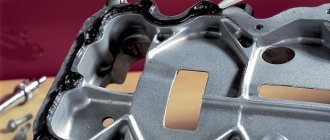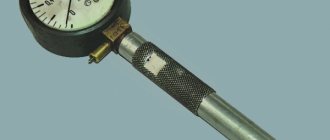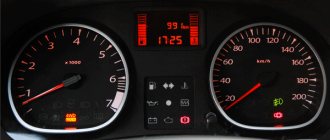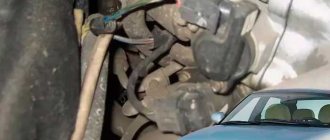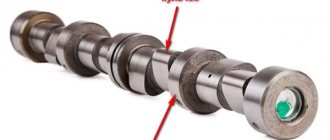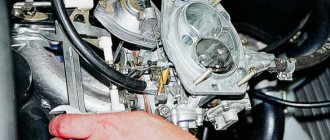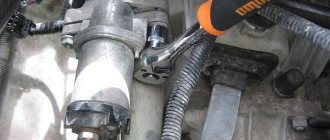Engine compression
Engine compression indicates the condition of the engine, its service life, power, and torque. This procedure must be performed every 20-30 thousand kilometers, as well as before purchasing a car. Even when checking at a service center, YOU will need knowledge of “how to correctly measure compression”, because... Servicemen love to deceive and make money from you. Let's start with the theory: Compression is the pressure created in the cylinder at the end of the compression stroke. Another term is appropriate here: Engine compression ratio. The engine compression ratio is expressed in the following ratio: compression/combustion chamber volume.
What compression should be in the cylinders of a VAZ engine?
Normal engine compression is at least 10 bar (1.0 MPa), and the difference between the cylinders should not exceed 1 bar (0.1 MPa). If your compression is 11-12-11-12 from cylinders 1 to 4, then the engine is fine, but do not forget to adjust the valves every 2500 km. If you have 11-9-12-11, then you need to look for the reason and make repairs, because Driving in such conditions will only kill the engine.
How much should the ideal compression be? The ideal compression should be 14 bar for an 8-valve engine in each cylinder with minimal variation (14-14-14-14).
What affects the error
Measurements do not always give the most accurate results, since they are influenced by certain factors. As a result, we get an error. Factors that cause inaccurate compression readings may include:
- Throttle not fully open. That's why it's important to press the gas pedal all the way down;
- Dirty air filter;
- Small gap between valves. This leads to a decrease in compression;
- Motor temperature. Data on a cold engine will be less than on a hot one;
- A cylinder head gasket that is damaged or burnt out;
- The presence of fuel in the combustion chamber. Because of this, the readings will be less than real. Therefore, it is important to expel all fuel during the preparation stage;
- Lack of proper sealing of the pressure gauge or compression gauge check valve. Use high-quality, serviceable measuring instruments;
- Low engine speed.
You can also check compression on a cold engine. Then the readings will be reduced by half compared to the norm, and the normal deviation is no longer 1, but 0.5 bar. Checking compression is not a complicated, but very useful activity that can be easily done with your own hands.
Loading …
The very concept of “compression” denotes the amount of pressure that the engine piston develops at maximum compression of the working mixture, that is, when it is at its lowest point. The higher this parameter, the higher the temperature the fuel-air mixture will burn, which means its consumption will decrease and the overall efficiency of the engine will increase.
Measuring compression of a VAZ 2114Compression of a VAZ 2114, in fact, like compression on any other car, depends on the following indicators:
- on the size of the clearance between the cylinder walls and the valves;
- on the volume of the incoming mixture, which, in turn, depends on the position of the throttle valve and the characteristics of the air filter;
- from the current engine temperature.
Read more: What kind of oil to fill in the VAZ engine of LADA cars » Lada.Online
In turn, the size of the gaps between the cylinders and the elements of the piston group can also have a number of reasons:
- high degree of wear or burning of their walls;
- incorrectly set clearance between the cylinder walls and the valves;
- the entry of liquid gasoline into the cylinder (not in the form of a mixture), which causes the oil to be washed away from the walls and the clearance to increase.
—> Masters VAZ / Engine / Cylinder block
VAZ 2112 engine compression, measuring pressure in engine cylinders
How to measure engine compression?
To check the compression we need a spark plug wrench, a charged battery and a compression gauge. You also can’t do without an assistant.
- Warm up the engine to operating temperature.
- We turn out all the candles.
- We install a device for measuring compression (compressometer) into the spark plug hole that appears.
- The assistant presses the gas all the way and starts the car within 6-10 seconds.
- We remember the compression gauge readings and carry out similar operations on the remaining cylinders.
How and what to measure
Compressometer
Compression is measured with a special device - a compression meter. It is a pressure gauge with a hose, at the end of which there is a fitting, either metal with a thread for a spark plug hole, or rubber in the form of a cone.
The process of measuring compression using a compression gauge involves placing a fitting in the spark plug hole and cranking the crankshaft with the starter until maximum pressure is reached.
Compression in a cylinder can also not be measured, but checked and compared with other cylinders.
To do this, unscrew all the spark plugs except one, and manually (using a wrench on the generator pulley nut) turn the crankshaft until the piston reaches top dead center.
Then they check the second cylinder, the third and the fourth in the same way, and compare the applied forces. Of course, this method is not comparable to measuring with a compression gauge, but it can help to understand which cylinder has a problem.
What should the compression be in VAZ cars?
The average compression rate for unboosted VAZ engines is 8-9 atmospheres, for forced ones with a reduced combustion chamber - 11-13 atmospheres.
In order to accurately determine the standard compression ratio, use the table that indicates the compression ratio in the cylinders of eight- and sixteen-valve VAZ engines.
| Number of valves | 16 | 16 | 8 | |
| Engine volume, l | 1,5 | 1,6 | 1,5 | 1,6 |
| Cylinder diameter/piston stroke, mm | 82/71 | 82/75,6 | 82/71 | 82/75,6 |
| Compression ratio | 10,5 | 10,3 | 9,9 | 9,6 |
Low and different compression in the engine, what to do?
If, after checking the compression, the compression meter shows below 10 bar in at least one cylinder, then you urgently need to find out the cause and fix the problem, otherwise you risk losing compression in the remaining cylinders.
If, for example, you do not have sufficient compression in 1.4 and any other cylinder:
- We fill a medical syringe with about 10 cubic centimeters of motor oil.
- Spray oil into the hole that appears.
- We measure the compression again.
If, after re-measuring, the compression has increased, it means the rings are worn out. If the result remains the same, it means the valves are burnt out or jammed. Stiff valves can be adjusted, and burnt valves can be replaced.
Increase compression
Yes, in some situations the compression can rise to 15 bar, which is not the norm. There is an explanation for this: all possible gaps are sealed with oil, there is no other liquid nearby. When engine oil splashes onto the piston group from below, the excess is removed from the walls by oil scraper rings. But when it comes from above, from the side of the combustion chamber, and even in large quantities, then it has nowhere to go. Part burns along with the fuel, causing white or bluish smoke to come out of the exhaust pipe, and the other part seals the cracks.
Oil enters the combustion chamber for the following reasons:
- valve oil deflectors (caps) have become unusable;
- After long-term use, the bushings inside which the valve stems move broke.
A good technician will eliminate the first reason without removing the engine head from the block by replacing the caps. The second will again require disassembly and pressing of new bushings.
High compression in the engine. Main reasons.
Don't be too happy if your compression readings are off the charts, this is in no way indicative of how cool your engine is. As stated above, the ideal compression for an 8-valve engine is 14-14-14-14. If your compression is higher than these numbers, then it’s time to think about malfunctions. High compression can damage the partitions of the pistons and tear the cylinders. Below are the main reasons for high/high compression: High compression is created due to excess oil in the cylinder, which is why it is sometimes also called “oil compression”.
- The valve stem seals (VSC) have worn out and died.
- The oil scraper rings are worn out or stuck. (In such cases, oil consumption is inevitable. Check the oil level: How to check the oil level in the engine? Also pay attention to starting the engine after a long stop, for example, in the morning. If the engine oil is consumed, the exhaust will be black).
- There may be carbon deposits in the cylinders. Try to get rid of it by decoking.
Causes of increased compression
When thinking about what the compression in an engine should be, it is important to understand that it should not be too high. And the reasons for this may be:
- Worn or stuck oil seals. You can see this problem without removing the cylinder head. When unscrewing the spark plugs, an oil film is visible in the spark plug wells. And it can be solved by replacing parts or decarbonizing them with chemicals.
- There is carbon deposits on the valves, carbon deposits in the throttle body and on the cylinder walls. It can be noticed when examining these parts.
- Errors in adjusting the gas distribution mechanism.
- Engine overheating.
Signs of poor compression
If you encounter the problems outlined below, then it is possible, BUT FAR FAR from a fact, that your engine has insufficient compression. Therefore, you don’t need to pay attention to the signs, but you just need to measure the compression.
- Misfires.
- Troit.
- Low dynamics.
- Engine knock.
- There is oil.
- Black smoke.
- Poor cold start.
- High fuel consumption (Causes of high fuel consumption on VAZ).
VAZ 2107 internal combustion engine compression standards
If there is a possibility of a motor malfunction, then the first thing you need to do is measure the compression ratio. To assess the condition of the CPG of a VAZ 2107 engine, you should first find out what values are considered normalized. What compression should be on a VAZ 2107 is a question that all owners of classics ask when they need to check the condition of the internal combustion engine.
The higher the pressure during compression of the fuel-air mixture in the combustion chamber, the better. The standard pressure value when compressing fuel assemblies in cylinders on a VAZ 2107 is 10-12 atmospheres. But this indicator is not appropriate for all engines. As you know, sevens were produced not only with carburetor, but also with injection types of engines. For carburetor and injection internal combustion engines, the lower threshold is 10 atmospheres or 1 MPa. The engine is considered to be in excellent condition if the pressure gauge shows a value of 13 Bar (this happens with new engines). A run-in working motor has a pressure value of approximately 12 bar.
Knowing how many atmospheres is the optimal pressure in the cylinders at the moment of compression, you can resort to the procedure for measuring this value. To do this, you will need a special device, which we will learn about in the next section.
How to determine compression on a VAZ 2107
Before the compression on the VAZ 2107 is measured, you will need to initially prepare the appropriate tools. To carry out the work the following are used:
- Spark plug wrench for removing spark plugs.
- A compression meter is a special device for measuring pressure in internal combustion engine cylinders during fuel assembly compression.
A compression gauge is needed directly to find out the pressure in the cylinders. Moreover, this applies not only to gasoline engines, but also to diesel engines. It is recommended to use devices with a threaded type of mounting fitting, as the readings with their help are more accurate. If the instruments are ready to measure compression, then work can begin.
- First you need to warm up the internal combustion engine to a temperature of 70-80 degrees, otherwise the data will not be accurate.
- After this, the fuel line is shut off, which prevents fuel from entering the combustion chamber. To do this, you can simply pinch the hose with a special tool or turn off the power to the fuel pump on injection cars.
- Start the engine and wait until it stalls on its own.
- All spark plugs from 4 cylinders are unscrewed.
- We prepare the device for measurement. A compression gauge is screwed into the thread of the first cylinder. Now you can begin to carry out measuring manipulations.
- To check the pressure, you need to have an assistant behind the wheel. He must turn the starter while pressing the gas pedal all the way.
- Turn the starter until the readings on the device stop increasing.
- When the maximum value is reached, it is necessary to take readings and record them. A similar procedure is carried out for all remaining cylinders.
How to increase engine compression in other ways?
There are several options for raising compression without repair. These operations do not in any way guarantee an increase in compression, but you can try. But it is still recommended to eliminate the malfunction by mechanical action - eliminate the malfunction: replace the rings or replace the valves.
- Adjustment of valves. I tried it myself, it really works. The valve could be jammed and therefore not close, resulting in a compression leak.
- Roscoking – removes carbon deposits and excess oil in the cylinder. It only helps with stuck rings; if the valves are burnt out, there is no point in carrying out this operation.
